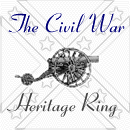

Regiment History: A few units won special notice for their rifle-skills, none more so than the 1st and 2nd Regiments of US Sharpshooters, consisting of the regulation ten companies with four from New York, three from Michigan and one each from New Hampshire, Vermont, and Wisconsin. The 2nd Regiment was commanded by Col. Henry A. Post consisting of only eight companies with two from New Hampshire, two from Vermont and one each from Minnesota, Maine, Michigan, and Pennsylvania. They were commonly known as Berdan's Sharpshooters after the colonel of the 1st regiment, Hiram Berdan.
Seeing their role as skirmishers and special marksmen, Berdan selected experienced men armed with the best weapons available, the Sharps Rifle in .52 caliber. Many also carried telescopic sights. The original recruits were told to bring their own rifles if they wished, with the promise, that the government would pay ($60) for each suitable weapon (a promise that was never kept). This created a problem of ammunition supply because of the different types of weapons they brought with them. Col. Berdan felt that the breech-loading Sharps rifle was the most reliable and the best possible weapon for his men. This was not well liked by General Winfield Scott of the Ordinance Department, whose attitude was that "the breech-loader would spoil Berdan's command". On President Lincoln's personal intervention, after witnessing a spectacular exhibition of marksmanship by Col. Berdan, the Sharpshooters were promised their Sharps rifles.
During the Fall and Winter of 1861 - 1862 one of the most popular attractions in the Nation's Capital was the training camp (Camp of Instruction) of the First and Second United States Sharpshooters . Local citizens, political dignitaries, even President Lincoln made frequent visits to the camp, for there, was gathered some of the best marksmen from the northern states. In addition to endless hours spent drilling and pulling guard duty, the sharpshooters put on daily demonstrations of their shooting skills before large crowds of camp visitors for whom target shooting was a popular sport.
While having no prior military background, Col. Berdan surrounded himself with experienced officers, many of whom were European. At "Camp of Instruction" with the help of these experienced officers, the Sharpshooters' training seems to have been practical and tough, being taught never to expose themselves recklessly, using any available cover and to waste no ammunition for the sake of shooting. All commands were given by the bugle, this and such aspects as their tactics and the styling of their uniforms, showed how much the commanders were influenced by Prussian Light Infantry and Riflemen.
With a view towards camouflage, Berdan clothed his men in green kepis or hats and dark green uniform frock coats. In keeping with the rest of the army, their trousers were light blue, but these to were later changed to green. They were held to the brogans with leather leggings. By 1864, the losses in the Sharpshooters regiment were such that they almost ceased to exist. At the end of the year they were consolidated into a single unit, and by early 1865 they were disbanded and the survivors dispersed into other regiments. The requirements to join the Sharpshooters was that no man would be enlisted who could not put ten bullets in succession within five inches from the center at a distance of six hundred feet from a rest or three hundred feet off hand.
The Sharpshooters' first action was a two company skirmish at Lewinville, Virginia, on the 27th of Sept. 1861, against enemy foragers. From then on they claimed participation in sixty-five actions and battles, especially distinguishing themselves at South Mountain, Chancellorsville and at Gettysburg.
The two regiments usually were designated as a brigade, but seldom could be employed as such, being constantly scattered as detached companies and used for skirmishing, picket duty or even sniping details, much to Col. Berdan's disappointment. This work was demanding, as it involved constant contact with the enemy, and loses were therefore continual. However, the usual trickle of recruits were all volunteers and were soon absorbed as good soldiers.
The storied exploits of the Sharpshooters were equally extraordinary; possibly some were even true. One claims that they had exploded a Confederate cannon in the Yorktown fortification by knocking sand from the embrasure into the muzzle by a series of well placed shots. This story fails to account for the fact that the Confederate gunners would have swabbed out the barrel; and any sand inside it, between rounds. And then there was "California Joe" (1st USSS, Co. C), a mild-mannered keen-eyed hunter of grizzly bears, had "shot a man out of a tree two miles off, just at day break, first pop." And who bought himself the first Sharps in the regiment and was much lionized by the illustrated weeklies of the day. A Confederate officer settled for a more modest estimate that they rarely missed a man at a mile, even though this was about three times their effective range.
One of the most well known stories was the noted twenty-minute fire fight in Pitzer's Woods, around noon on the second day of Gettysburg. The four companies of Sharpshooters engaged expended an average of ninety-five rounds per man. Because of this firepower, the confederate General Wilcox is supposed to have reported the force opposing him there (actually 100 Sharpshooters and 200 men of the 3rd Maine Infantry armed with muskets) as two full regiments.
The First Regiment was mustered out of service beginning August, 1864. Those men whose enlistment had not expired, transferred to the Second Regiment. The Second Regiment, in turn was mustered out in February, 1865. It's men whose enlistment were not yet up, transferred in companies or as individuals, to regiments of their respective states.
These two regiments were, in a sense, modern infantry. Their morale seems to have been generally excellent. Very few ever became prisoners of war. Though their employment was not fully understood, they could boast that they killed more Confederates than any other two regiments in the Union Army.
In passing, some comment should be made on the erroneous story that the word "Sharpshooter" derives from the use of the Sharps rifle, this fact is far from true. The "Scharfschtze" existed in Germany and the "Sharpshooter" in America decades before the Sharps rifle was invented; indeed even before it's inventor had been born.
Uniform Data: Captain C.A. Stevens: the Sharpshooters' historian, described their uniform as being; " of fine material, consisting of a dark green coat and cap with black plume, light blue trousers (later exchanged for green trousers) and leather leggings, presenting a striking contrast to the regular blue of the infantry. The knapsack was of hair covered calf-skin, with cooking kit attached, considered the best in use, as it was the handsomest, most durable and complete. By our dress we were known far and wide, and the appellation of "Green Coats" was soon acquired. When fully uniformed and equipped, the sharpshooters made a very handsome appearance, more so upon the whole than many others".
From what I have collected so far the Sharpshooters had two distinct uniform types. First is the forest green uniform(green) with kepi, forage cap, or Hardee hat for the summer and Miller's Gray(with green piping) for fall and winter (I can't find a lot of information on the Miller's Gray uniforms, so I assume they did not last long). The great coat was Miller's Gray with green piping, but these were later traded in for standard US great coats. Buttons were black made out of hard rubber, and the knapsack was made in Prussia(I have not found a source for the pack yet), they were ordered and purchased from "messr's Tiffany" of New York City costing $3.75 each. These were traded in for the standard issue knapsacks in mid May of 1862.

Visit the 1st Regiment U.S. Cavalry, K Troop Homepage for information about this unit from 1833 - 1892.
[
Sign my GuestBook ] - [ Read my GuestBook
]
[ GuestBook by TheGuestBook.com ]

 This Civil War Heritage Ring site is owned by
This Civil War Heritage Ring site is owned by Mike Oxford. Enlist in the Civil War Heritage Ring! |
|---|
| [Skip Prev] [Prev] [Next] [Skip Next] [Random] [Next 5] [List Sites] |

 by 2nd Lt. Michael S. Oxford. Want to join the Union Army Ring? [Skip Prev] [Prev] [Next] [Skip Next] [Random] [Next 5] [List Sites] |